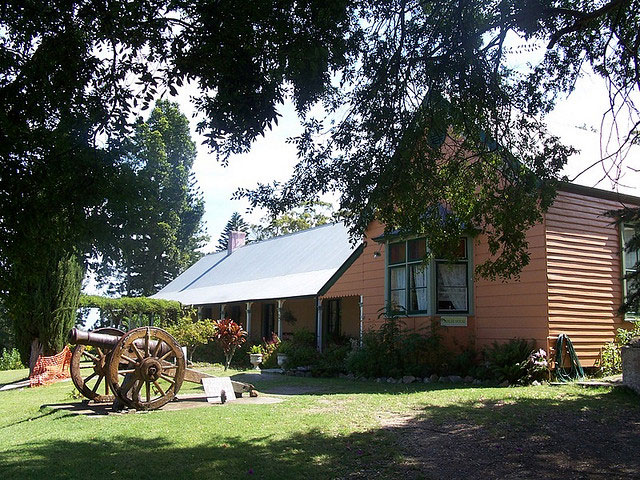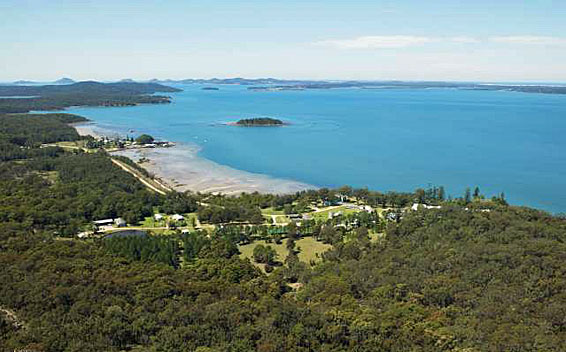Sold to St Philip's Anglican Church, Eastwood 1932 Reb. C.W Leggo
Reb. & enl. 1968 S.T. Noad & Son.
Now broken up.


Tahlee House (Google Images)
Tahlee House
Tahlee House was originally built of sandstock brick in 1826 for Robert Dawson, the first manager of the Australian Agriculture Company and home to the first four commissioners of the A.A. Co. The house was destroyed by fire in 1860. The Hon. R.H.D. White, a Sydney stockbroker, purchased Tahlee in 1880 and built a new residence on the remains of old, utilising the remaining walls. The home featured a beautiful garden, ball room and tennis courts and was the centre of extravagant hospitality, entertainment and general carousing. The boat harbour at Tahlee was originally built by convicts. [information from a Port Stephen's tourist brochure]
The property was bought by Tahlee Bible College in 1959 and has been used as a Bible College until about 2005. It is still owned by the Bible College and its future is uncertain. The College has a web site.

The three-manual organ at 'Tahlee House' about 1890 (James White)
From the Sydney Organ Journal (Spring 2011), James White (great grandson of Robert White) wrote:
Robert Hoddle Driberg White was born in Stroud in 1838. As a politician he represented Gloucester in the NSW Parliament from 1882 to 1887. He was a bank manager in Mudgee, Rockhampton and Kyneton. He married Eliza Jane, a daughter of the Very Revd William Macquarie Cowper, at St Philip's, Church Hill, in May 1863. Whilst residing in Mudgee he ordered a pipe organ from Hele & Co of three manuals and twelve stops. However, the ship carrying the organ to Sydney was shipwrecked and all its cargo lost at sea. Undeterred, in 1882 he donated the Brindley and Foster organ to St John' s, Mudgee where he was Rector' s Warden and a chorister. In about 1886 he purchased Tahlee House on Port Stephens from the Australian Agricultural Company. While he revisited England later in 1886 as a representative of the Colony of NSW at the Colonial and Indian Exhibition he re-ordered an almost identical organ (3/14/6) from Hele for installation in Tahlee.
Robert White had two violent encounters with bushrangers and came off best both times. The first time, White was taken by surprise at dinner time in Deniliquin by William Lee of Bargo Brush notoriety. However, aided by a black tracker, White pursued the culprit through the night, recovered some of the bank's gold and obtained information which led to Lee's arrest a fortnight later. The second time White was "stuck up" by five armed men on the Gympie Road. In an exchange of fire White wounded one of the bushrangers but himself escaped unscathed. In 1880, Robert White learned accidentally that he had inherited considerable property in Melbourne from his grandmother, Mary Hoddle. However, his grandfather Robert Hoddle, influenced by his second wife, had concealed knowledge of the inheritance and destroyed the relevant documents. In a celebrated court case, Robert White sued his grandfather and won. It was this money, about two hundred thousand pounds, that enabled him to make substantial donations to churches, to purchase one and to donate wholely or in part three pipe organs. It is noteworthy that of these, three were of three manuals and pedals. The specification of the organ donated to the Deaf, Dumb and Blind Institute in Sydney, its maker and present whereabouts are unknown.
The Hele at Tahlee House was said to be the smallest three-manual organ at the time it was built and was sometimes misreported as the first three-manual organ in Australia. After Robert White died in 1900, Tahlee was held in trust for his widow until her death when it passed into the hands of their son, ABS White, the founder of the famous stock-broking firm, ABS White & Co. The organ remained at Tahlee, probably without any maintenance, until about 1931 when it was purchased by St Philip's, Eastwood1 for four hundred pounds. It remained intact until about 1968 when it was rebuilt and enlarged, in the process losing much of its pipe work and case. The work was carried out by ST Noad & Son with the then church organist as consultant. It became an organ of three manuals, twenty-seven stops and eleven couplers with a detached Wurlitzer-style console. As with so many 'renovations' it did not last much more than twenty-five years before it broke down completely. In about 1989 the church officers decided to dispense with the Hele/Noad organ altogether and purchase an electronic instrument. The remains of the pipe organ found their way to Toowoomba Presbyterian School and the soundboards and trackers to a private residence on the Central Coast before these, too, were dispensed with.
The specification of the Hele organ as ordered by Robert White was:
| Great Open Diapason Flauto Principal Piccolo Swell Gedact Gamba Voix Celeste Gemshorn Oboe Choir Gedact Dulciana Lieblich Flote Pedal Bourdon Bass Flute Couplers Swell to Great Swell to Choir Choir to Great Great to Pedal Swell to Pedal Choir to Pedal |
8 8 4 2 8 8 8 4 8 8 8 4 16 8 |
Compass: 58/30
Parallel, flat pedals
It is not known whether Robert white actually played the organ or not, but it seems certain that he enjoyed the sound of an organ. The organ at Tahlee prominently graced the ballroom among the Louis XV chairs. Here he entertained many guests and also held church services at which he invited local ministers to lead and preach. While he was a commissioner for NSW he appeared to take a keen interest in Sydney's Centenary Hall project, 1885-1890, and in particular the installation of Hill's "magnum opus". Thus, when William Thomas Best, organist at St George's Hall, Liverpool, was engaged to perform the opening recitals on the new Town Hall Organ, Robert White took up the position of keen observer and ambassador. While Best was on his way to Sydney, Robert White travelled to Albany to meet the special guest and escort him to Sydney on the SS Austral. Since the organ was still incomplete Robert invited Best to stay at Tahlee. Best would surely have enjoyed many an hour entertaining White on the Hele organ and White would surely have been present in the Town Hall on that memorable inauguration day, 9th August 1890.

Aerial view of Tahlee (Google Images)
1 ST PHILLIP'S ANGLICAN CHURCH, cnr Rutledge Street & Shaftesbury Road, Eastwood
B. 1886 Hele & Co., Plymouth for "Tahlee House", residence of R.H.D White, Esq., Port Stephens
Inst. present location 1932 C.W. Leggo.
Reb. & enl. 1968 S.T. Noad & Son.
3m., 27 sp.st., 11c., el.pn.
Gt: 8.8.4.2-2/3.2. Sw: 8.8.4.4.III.8.8. Ch: 8.8.8.4.2-2/3.2.1. Ped: 16.16.10-2/3.8.8.4.4.
Rem. and reb. for residence of Geoff Bock